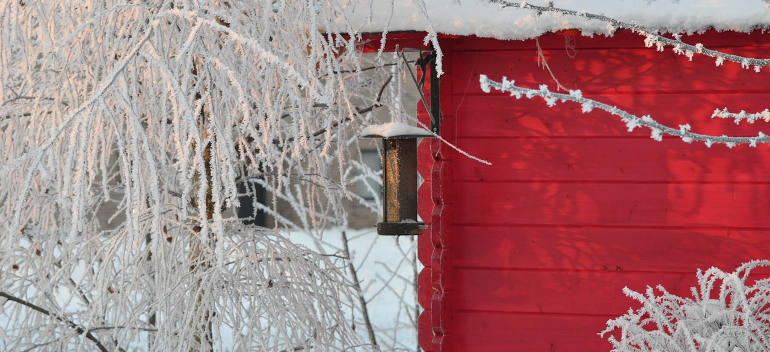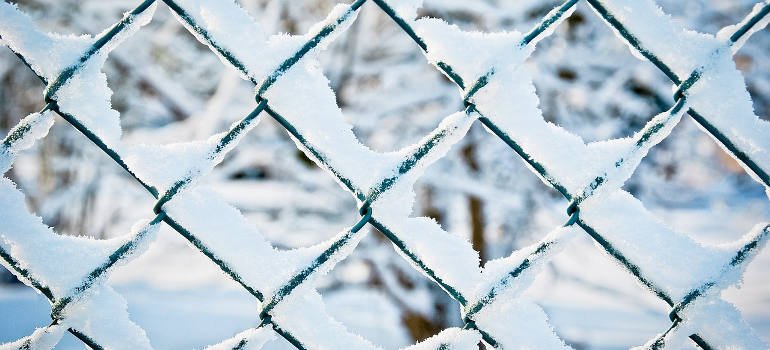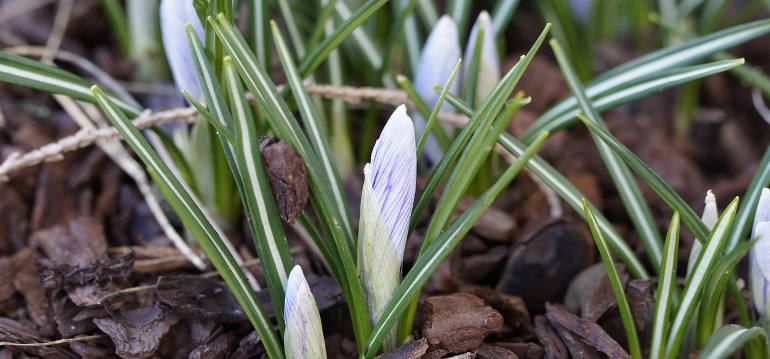
Winter is coming, and with it come gardeners fretting over frostbitten plants and damaged crops. Fear not, ladies and gentlemen – let’s introduce you to our extensive guide on how to protect plants in winter.
Table of Contents
How to protect plants from frost

Tender plants are the ones mostly threatened by negative temperatures. Water expands when frozen – and liquids inside the stems of the plant obey the same physics rules. The plant will suffer a gruesome damage beyond fixing, bursting into pieces. However, different plants react in a variety of ways.
Some perennials with strong roots survive through winter, albeit the damaged foliage. Others, such as summer vegetables and annuals, spring blooming shrubs and trees, tropical plants and potted plants won’t make it that easy.
Here are the steps you should take to protect plants from frost:
- Bring the plants indoors – Nothing will work as good as bringing your tender plants inside where it’s warm and dry. Get the bulbs in as well – dig them out, transfer them to a container and store them indoors.
- Place tender plants under glass – Tender plants that cannot tolerate low or near freezing temperatures, such as perennial summer bedding plants, must be overwintered in a greenhouse or similar, where temperatures don’t fall below 4-5°C. A cloche is one of the best ways to protect plants from frost in the vegetable patch, too.
- Protect slightly tender border plants by applying mulch or soil – Winter damage usually happens when the roots become frozen solid for extended periods. A layer of mulch (7.5-10cm deep) around plants like Penstemon, Phygelius, ‘hardy’ fuchsias and other slightly tender plants will keep the roots from being damaged by winter frosts.
- Supply enough water – Plants should be watered in the morning in winter or when there is a chance of frost because damp soil absorbs heat during the day.
- Take care of sprouts – You will need to lay a thick blanket of mulch on top of them or use a flower pot to cover the tender sprouts. If the temperatures rise during the day, it will be okay to uncover them.
- Cover larger plants – Use garden fleece, bubble wrap, fabric or old sheets to cover larger shrubs and trees completely from the top to the ground. You need to do a tight package since most of the heat is coming from the ground, and if the fabric reaches it, it will trap it inside the bubble. When the temperature rises again, you should uncover the sheets.
- Damage control – If frost is coming, don’t use any fertilisers to speed up plant growth – you need to avoid tender plants being exposed to cold. Container gardening and sheet wrapping are arguably your best choices – more on them later on. If parts of your shrubs and trees get damaged, branches for that matter, you can wait until they start growing. Then you can easily access how much damage they have taken and only cut out the dead parts.
- Swathe pots in bubble wrap – Despite that having a greenhouse is a robust protection against cold, you still have many other palpable ways of ensuring the longevity of your vulnerable plants. And one of them is insulation. Even concrete containers can’t protect the plants fully inside – the materials cracks and frost slowly reaches the roots. Therefore, it is necessary to wrap the whole container together with the plant in bubble-wrap.
How to protect plants from frost with fleece

Horticultural or garden fleece is a lightweight, soft-textured polyester material collectively known as crop cover. The porous nature of fleece, which allows water and air to pass through, creates a healthier environment for plants than polythene. As a versatile material, fleece can protect plants from wind, frost, hail, and pests.
Standard fleece with a weight of 17g protects to just below freezing, while 30g fleece protects down to around -3°C. Individual or groups of plants can be covered with fleece sheets and pegged or strung together. You can leave the cover on for weeks or months if there is a gap between plants and fleece.
If the fleece is in direct contact with the plants, you should remove it as soon as possible (when the weather improves) since it reduces the amount of low winter light reaching plants and provides a haven for pests.
For exotic trees, such as pomegranates, olives and palms, you need to keep all parts of the plant insulated. Warmer temperatures in autumn or early spring can be a mixed blessing, too. Even conventional northern crops, such as cherries, can also bloom early and get a damaging frostbite.
How to use horticultural fleece
- Put on gloves – you don’t want to injure yourself;
- Pull up the tree branches – you may probably need assistance, based on the size of the tree crown;
- Tie them up with twine;
- Wrap the branches with horticultural fleece;
- Tie up the coat to secure it;
- Step back and marvel at your tree, ready to face the frostbites daringly;
Plants can be protected from temperatures as low as -5°C with fleece ‘jackets’, which are made of 70g fleece. They are available in a wide range of sizes.
When to cover plants for winter?
Different plants freeze and die at different temperatures. If a frost is expected (0 degrees Celsius), you will need to take care of some frost-sensitive plants. Sometimes temperature drops are quite sudden, so don’t wait until the last minute to question yourself “аt what temperature should I cover my plants”. In the evening, before sunset, is the ideal time to cover the plants so more warm air will be trapped under the cover material you choose.
If you use a plastic cloche to cover your plants, use it in the late afternoon so that it will trap more heat.
If you use a plastic cloche to cover your plants, use it in the late afternoon so that it will trap more heat.
The best time to wrap a blanket around a cloche is in the late evening before sunset.
What is the best time to uncover my plants during the day?
To be on the safe side, you can uncover your plants in the mid-morning when the temperatures get higher. You can leave them covered if the cold persists during the day. It is important to note that if a frost blanket covers plants for too long, they may suffer from a lack of sunlight. Cloches or row covers are a better option for extended periods of cold as you can leave them on for weeks or months.
What to use to cover plants from frost?
Can you use garbage bags to cover plants from frost?
Putting a plastic trash bag over your plant before winter begins may be your first thought, but garbage bags aren’t breathable, so moisture can be easily trapped inside and freeze your plants when the temperatures drop. Also, plastic and vinyl materials are typically too thin to provide sufficient insulation for plants.
Can you use sheets to protect plants from frost?
You can protect plants from a freeze simply by covering them with sheets or blankets if you’re expecting a light freeze. By doing this, warm air will be trapped around the plant and could keep it for short-time freezing.
Once an overnight cold snap has passed, remove the sheets, blankets, and plastic right away. If you do not do this, condensation can build up under the covering and damage the plant.
Can you use cardboard boxes to protect plants from frost?
Yes! Indeed, cardboard boxes aren’t perfect – but they can keep out cold and protect plants from frost damage. Cardboard boxes are a good choice because they give the plant enough space without being in direct contact with the leaves.
Place the cardboard box over the plant in the late afternoon hours while the sun is still present to allow the interior of the box to warm up gradually. You can then remove the cover and allow your plant to breathe and absorb the sun once the risk of frost has passed.
How to protect plants from frost through cultivation

Very often the reasons for plant frost are rooted in improper gardening techniques – untimely fertilising, missing out on dealing with garden pests or insufficient watering. Here are a couple of horticultural tricks to fend off frost:
- Feed plants timely. Avoid fertilising and watering during the second half of the autumn and the summer seasons, so that you don’t stimulate early bud growth.
- Water properly. Another bright idea is to keep the soil around the plant, especially around orchard trees and shrubs, moisturised by watering it more often. It will hold the temperature at a lower degree and will prevent the plants from early blooming. Apart from keeping the root system cool, the water will maintain the air around the plant a touch cooler.
- Cover the soil. You can use mulch or manure, to reduce erosion, air exposure and nutrient loss.
- Choose the right planting spot. Your garden is a battle plan. You have to spread your units, being the plants, in the right places, so that they receive the optimal amount of nutrients and sunlight they need, without getting damaged by external conditions. Sunlight gets reflected by south-facing walls which means that area will be warmer, as opposed to north-looking sides. Early morning sunlight shouldn’t get to early blooming plants – the thawed snow can blacken their buds.
- Plant shrubs to break the wind current. If your garden is in a windy place, planting hedges around will reduce the chance of your plants get damaged by air outbursts. However, by the time hedges grow big enough to protect them, you can also use netting or any other hand-made materials, placed on stable posts. In addition to new structures, check out any loose parts of fences or panels. Go for the ones that allow some wind to pass through – you will avoid any unpleasant noises, turbulence and wind gust.
How to protect plants from winter rain

Winter rain can be a nightmare for potted plants since moisture can quickly build up on the bottom of the containers. Subsequently, roots are deprived of oxygen and die off. Here’s how to up the game of your containers:
- Get yourself a pot with holes for drainage at the bottom;
- Use the proper compost – get a well-drained one, so you don’t start at a disadvantage;
- Raise the pots on a platform – you can buy those at any garden convenience store – they will lift the container around 3 cm above the floor. Not only moisture will drain, but also the air circulation around the pot will improve.
How to protect plants from frost in a greenhouse

Do’s:
- Fill containers with water to absorb sunlight during the day and reduce chance of frostbite in the evenings;
- Insulate walls with bubble wrap or horticultural fleece to trap the heat in;
- Add more light sources – grow lights will do a good job;
Don’ts:
- Don’t overdo the walls with bubble wraps – you don’t want to block the sunlight completely;
- Additional heat sources may raise costs over plant value – consider them out of the picture, when it comes to greenhouses;
- Don’t spare on water when it comes to greenhouse watering – the plants inside usually need much more than normal. Check if the soil is still dry at around 2.5 cm depth – if yes, then you should water more.
Hopefully, now you are all set to rock it in your garden during these troubled times of cold. Remember, you can always count on us to take care of your greenery and book a garden maintenance service. It may be cold outside, but your plants don’t necessarily have to look so, too.
Need a gardener?
Enter your postcode to view our rates and availability in your area.
For questions about the services we offer visit our main site or you can always call us at 020 3404 4881



